As a Geologist, you will need to travel a lot. Your job will require you to leave your comfort zone and head into unfamiliar territories. At times, you may be forced to use a piece of entirely different equipment, as the stuff you use back home isn't available.
One such essential product is the core box or core tray.
Core Boxes vs. Core Trays
What's the difference?
If made from cardboard or wooden, they are classed as a box. Made from plastic or metal they are classed as a tray. Whatever the name you choose to call it, a core box or core tray is fundamentally the same thing.
Core Box or Core Tray Universal Definition:
A receptacle to help log, store, and transport your diamond drill core samples.
Wherever in the world you are drilling, you'll find and need a core sample holder of some shape, size or material.
What are the different kinds of core boxes?
- You'll find these 4 varieties being used around the world:
- Metal galvanized steel/aluminum core trays
- Wooden core boxes
- Plastic core trays (injection molded)
Apart from the material, one of the obvious differences is the length and width of each. There is no global standard or practice.
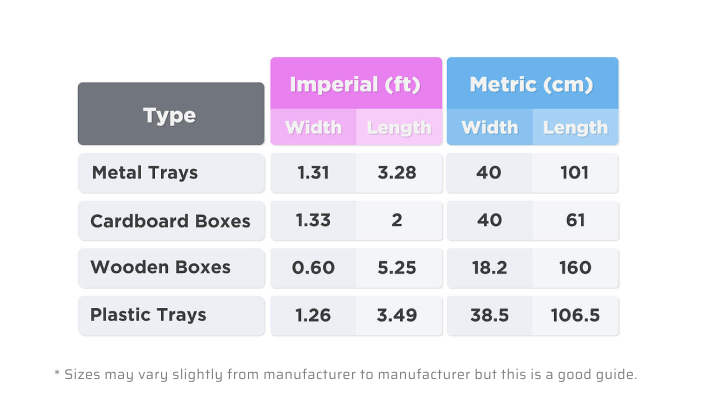
The chart shows the external dimensions of the box. Now let's move on to core capacity.
Core Capacity
Cardboard Boxes are logged in feet, so each row is 2ft and typically the H, N & B box holds 10ft of core. Metal, Plastic and Wooden Boxes are typically logged in meters, so their length corresponds with the meter.
- Wooden: 1.5 meters per row
- Plastic: 1.0 meters per row
- Metal: 1.0 meters per row
Total core capacity depends therefore, on the number of rows inside the tray or box. It's typically the old imperial/metric story, hard to move away from what we are used to.
Now that you have a fundamental overview of the sizes, we want to recognize each material and explore its pros and cons.
Let's jump right in!
Metal Galvanized Steel Core Trays
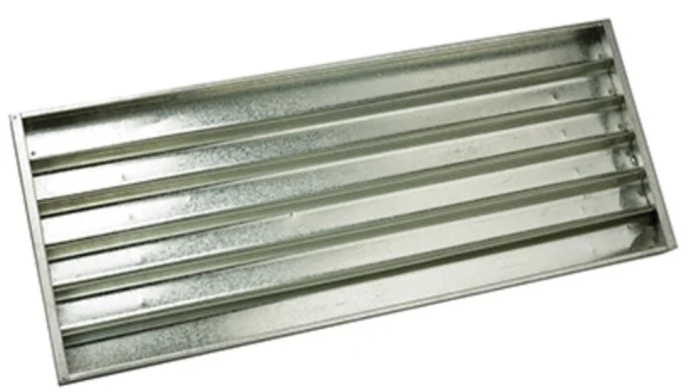
We believe Noah had a couple of these on the ark...
On a serious note, metal core trays have been used for decades, dating back to the late 1800s; perhaps even before.
Pros
- Sturdily built
- Can easily be manufactured to custom lengths/sizes
Cons
- Very susceptible to either freezing or burning your hands, depending on the prevailing climate
- Sulphide ores react with metal. This can lead to corrosion, contamination, and core loss.
- Heavy to lift
- Unstable stacking functionality
- Can have sharp edges leading to Lost Time Injuries (LTI)
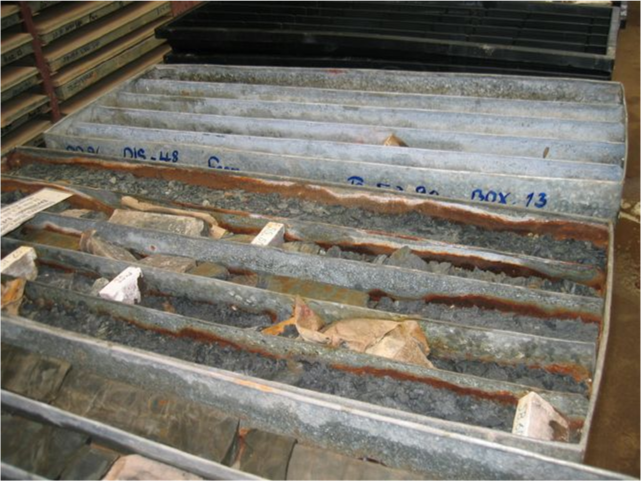
As the world evolves and drilling programs are continuously fine-tuned for efficiency, we are seeing the use of metal trays die off dramatically.
Whilst they've served us well historically, in our research we reckon their days are numbered as shown by usage trends.
Wax Cardboard Core Coxes or Plastic Corrugated Core Boxes
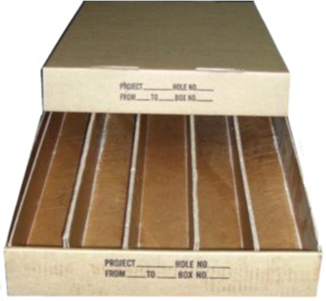
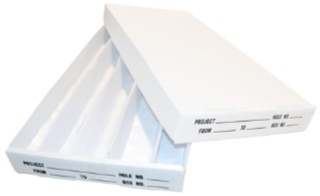
You'll predominantly find these type of core boxes in active use in the US. For this exercise, we grouped them based on similarities in their properties.
Pros
- The supply chain of these products is well established in the USA
- Easy to transport a large number of boxes due to its flat-pack nature - entire 'drill holes' worth' can be taken to the rig
- Lightweight material; one-person lift possible
- Cost-effective per box (more on this later)
- Comes with a lid providing large flat areas to write on
Cons
- To get the longest shelf life out of the boxes, internal storage is a must
- When laden with rock, cardboard, a naturally flexible product can collapse (not commonplace, but possible)
- Assembly before use is required (we acknowledge this is not a con to some readers)
- The cardboard dividers can easily shift away from their original positions as below, leaving core that isn't perfectly straight - not the perfect scenario when taking images or scanning (this will become more important as more geos incorporate the latest scanning or imaging software)
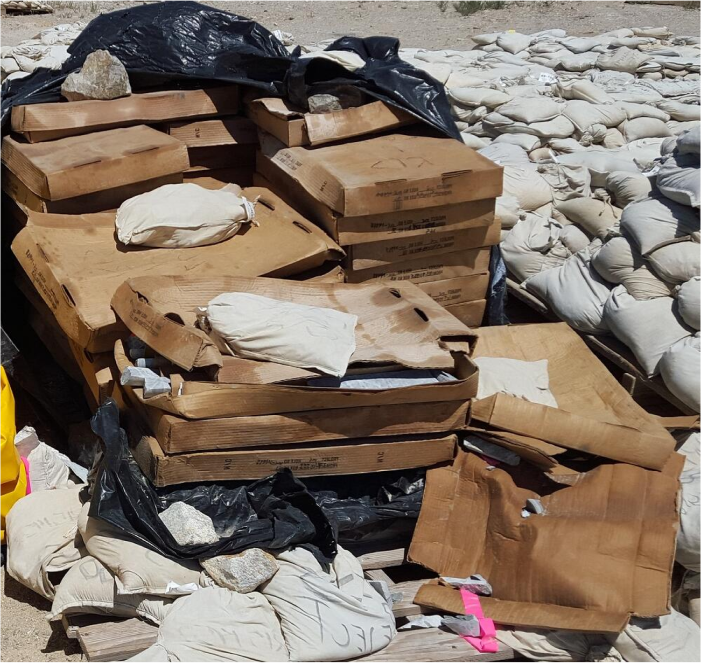
- Not good for humid or really cold environments where moisture is predominant (no real drama in dry hot places, like Nevada)
- Companies additionally invest in shed structure and shelving needed for storage (read on to see why this need is negated for other core box materials)
- Being a shorter 2ft box, the core has to be broken more to fit into the box
Now, we understand that some geos are going to read these cons and think 'get real'.
But take this con for example, 'assembly before use is required.'
As an experienced geo with cardboard boxes, this is something you won't think twice about because it's become a practice; most likely, you won't consider it a con.
However, there will be geos reading this who have never assembled a cardboard core box.
For them, it's a new and different concept.
The reality is that if you've never assembled a core box before use, it's highly likely you'll think this is madness.
It's like a geologist who's used to loading up an entire drill hole's worth of cardboard boxes on the back of their vehicle would think it's madness to load less wooden/plastic boxes and make more trips.
Whatever happens, you can take hundreds of flat-pack boxes out to the rig, and coming back, you'll still need to bring the same volume of drill core samples back from the rig.
You can't flat-pack core. :-)
Bottom line: There's no one size fits all.
Wooden Core Boxes
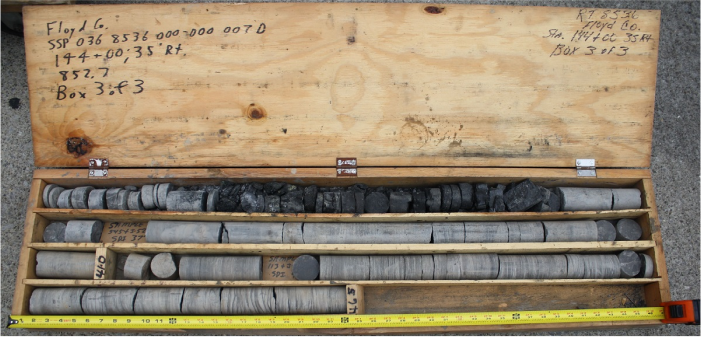
From our research, colder climates are the largest users of the wooden box—Canada, Mongolia, Kazakhstan, Sweden, to name a few; also typically where timber is readily available.
As we understand it, the use of wooden box in these regions is led by the belief that nothing else can handle the sub-zero temperatures.
Pros
- Timber, as a resource, is readily available in countries using wooden boxes, often helping local communities
- Easy to custom build in a variety of sizes
- Strong, rigid product
- Good in cold climates
- Due to their long and narrow design, they can be handled by one person carrying them 'on the hip'
Cons
- Susceptible to termites and insects (only important in regions of the world these insects thrive)
- Timber will rot when left to the elements and this can lead to core loss or sample bias (in colder climates, rot is rarely a problem and wooden core boxes will likely last for years)
- Wood splinters in hands can occur on occasions (fairly rare)
- Typically heavier to lift than competing materials
- Harder to photograph due to its long and narrow shape; not the perfect camera frame size
- Deforestation is involved; not good for a company's Corporate Social Responsibility image (this argument may not necessarily hold any weight in some regions of the world)
Overall, wooden boxes are fundamentally a great product, and have been used for years, and possibly years to come
If you are a smaller-built person, lugging these around could be more difficult.
Lifting these on the hip is a common practice, but is it the most ergonomically friendly way of lifting these so your back thanks you later?
Apart from that, they do the job they were designed for perfectly.
Plastic Core Trays (Injection Molded)
.jpg?width=701&height=531&name=AFB_%20S4-NQ%20(1).jpg)
Plastic core boxes are not new technology.
As plastic is a man-made product, the possibilities of utilizing innovation with this product are boundless.
The plastic core tray has become so much more than a basic core sample container.
The innovations built into the plastic core box are eliminating entire sections of the downstream processes leading to huge savings of thousands of dollars and man-hours.
As we manufacture the Discoverer® Plastic Core Boxes, the features we discuss below relate solely to this brand.
If plastic is something that interests you, and you're looking at a different brand, just check that it lives up to these features, as not all are created equal.
Discoverer® is the world's leading plastic core box brand since pioneering the market in 1993. It has since been used in the hottest and coldest climates around the world and has a proven track record of durability.
Pros
- Global Lifetime Warranty - at the time of writing, Discoverer® is the only plastic core tray brand in the world that goes the extra mile to offer this level of assurance on core boxes
- It's been tested and proven in 140°F / 60°C high temperatures, and -58°F / -50°C low temperatures
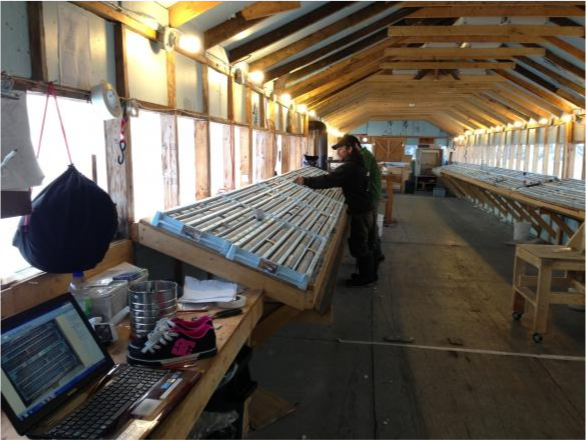
- Designed to be stacked on pallets and left outside for the entire life of the mine; the expense of building shelving or a storage shed is completely removed
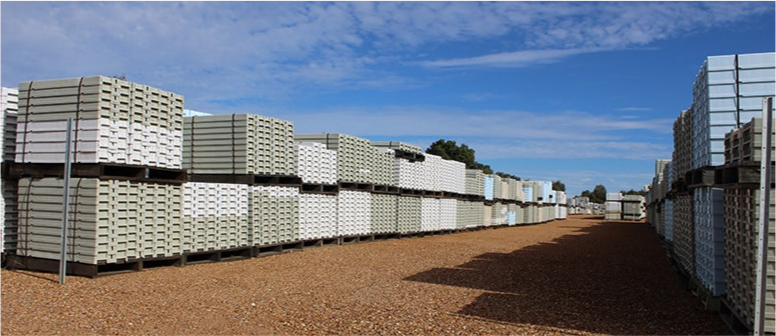
- Unique Tru Identiti™ stencil is inbuilt into the plastic molding, to eliminate any issues caused by poor handwriting
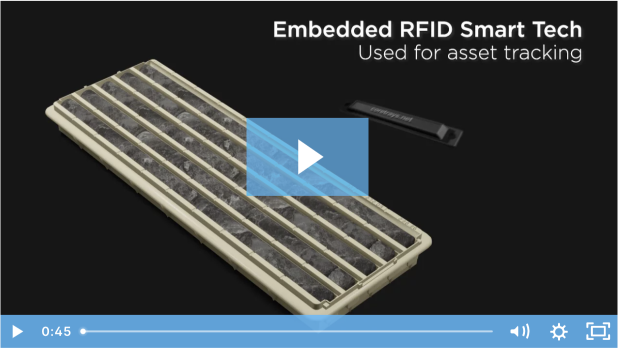
- As the tray is photographed, core imagery software Imago identifies the stenciled information and automatically assigns it to the photo and the corresponding database
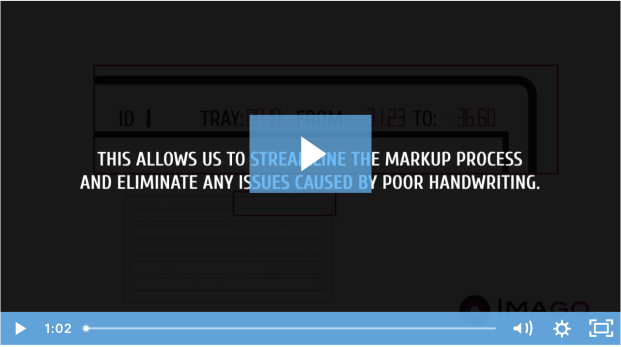
- Ability to embed an RFID tracking chip to eliminate core tray markings or ID labels going missing. This also ensures the tray can be identified in downstream processes, such as during logging, sampling or core tray inventory management.
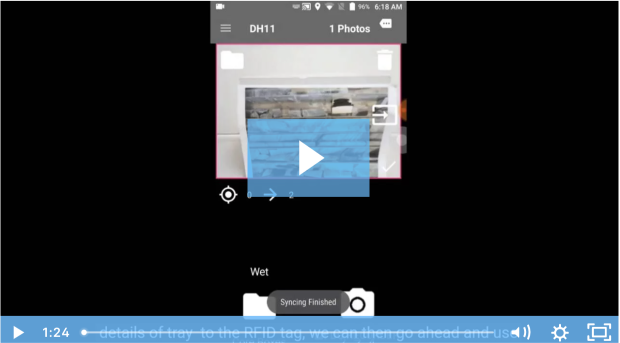
- Made from a chemically inert product and not susceptible to sulphide corrosion. In many cases, the core sample would have disintegrated after a 25+ year period but the box can be reused.
- Lightweight to carry, but exceedingly durable with high-impact resistance (think car bumpers)
Watch this 4.5T Pickup Test in Nevada!
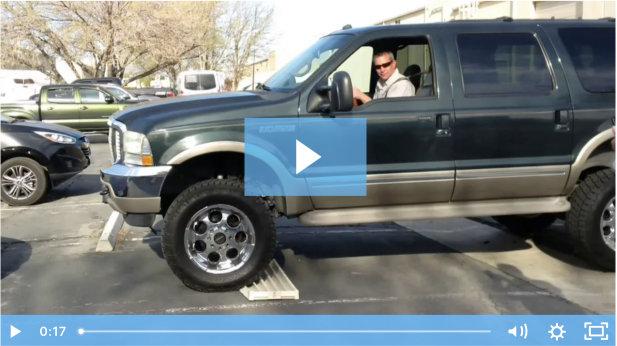
- Has UV stabilizer to ensure the product lasts outdoors for the entire duration of mine life (30-40 years and even beyond). Indoors, it'll last forever.
- Recycled plastic is used in the manufacturing process, giving your Corporate Social Responsibility and sustainable mining efforts a boost.
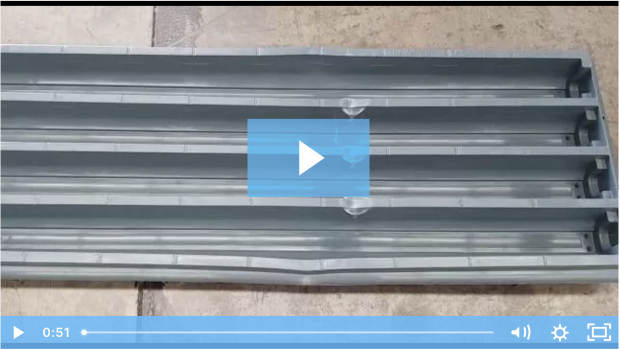
- Metal tags are fitted into each box allowing for indelible markings to be inscribed into the metal. The problem of unidentifiable boxes downstream is eliminated.
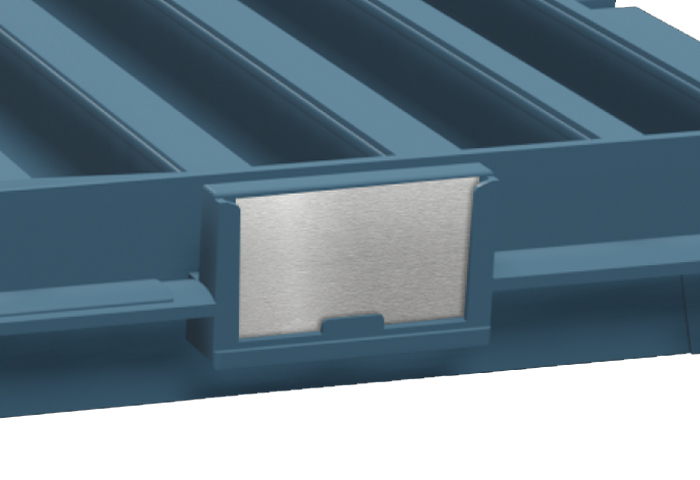
- With reinforced cross bracing, injection molded trays can be built very rigidly with little noticeable flex.
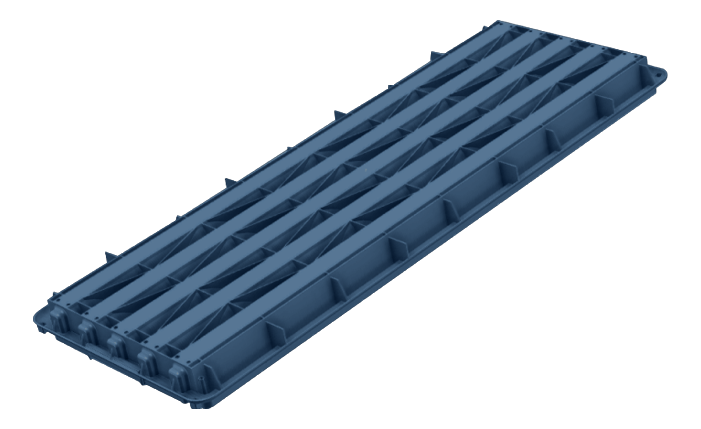
- No need for a lid on every tray. Each tray when stacked becomes the 'lid' for the one below it. Lids are only needed to be fitted to the top tray of the stack. (The video below shows Discoverer® S2, which 'nests' inside one another when empty, and stacks neatly on top of each other when full.)
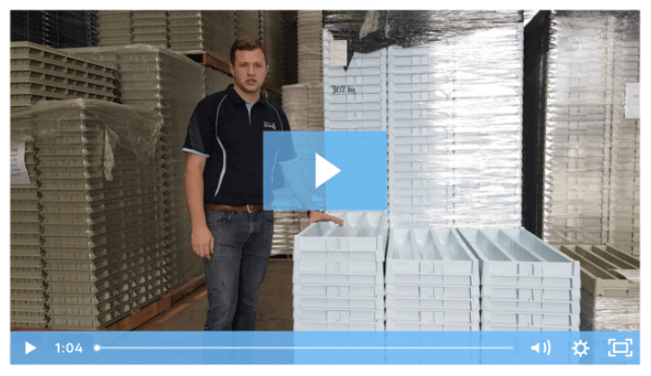
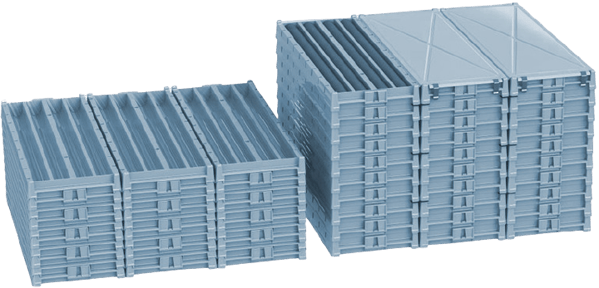
- Not susceptible to termites or rot
- No need to DIY assemble the boxes on site
- Global export is common practice
Cons
- Not locally available in every region of the world. This is fast changing as more Discoverer® distributors come on board every year (more on this later when we talk distribution).
- As they aren't flat-pack, these can be a little bulkier, leading to higher transport costs.
- You are limited to the sizes the manufacturer offers as the injection mold tooling is expensive to set up.
With the pros vastly outweighing the cons, it's surprising that the plastic core tray is steadily becoming the most preferred form of storing and transporting core across the globe.
But is it the right choice for you?
"Which core box is right for me?"
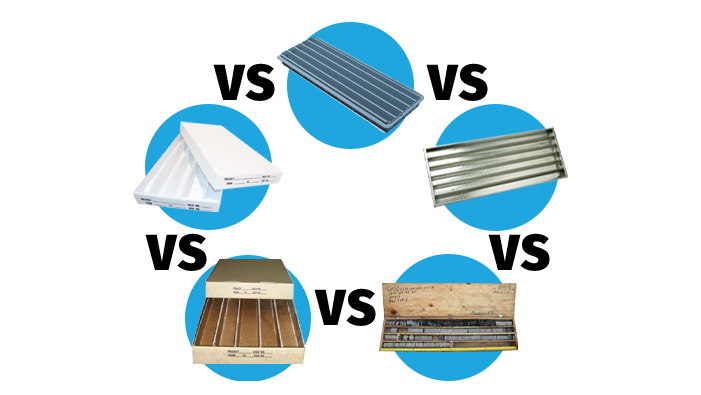
There you have it—the complete comparison: Metal, Wooden, Cardboard and Plastic Core Boxes.
At this point, you've most likely made a decision, consciously or subconsciously.
Decision #1: "Great! I knew I was using the product that was right for me."
This is where you can relax, no need to read any further. We are glad we helped solidify the decision in your mind.
Decision #2: "Hmmm... That was interesting, maybe I should explore my options further?"
The world is changing. Will you evolve or hang on to the dying practices of old?
"Why should I consider changing my core box?"
Perhaps you shouldn't?
Either way, there is no right or wrong answer.
Better the devil you know right...?
Now, we're glad you made it this far because it means you made Decision #2.
You were willing to consider that your fellow geologists, wherever they are around the world, are fundamentally well-educated, smart people.
All around the world, we are harmoniously using the core boxes of our choice, aren't we?
Or not...?
These are the predominant factors affecting geologists' choices today:
- Cost
- Availability of supply
- Suitability
- Personal preference
- Industry best practice
We've pretty much covered suitability and personal preference above. Your thoughts on both these subjects could potentially have been given an 'a-ha' moment.
So let's discuss the other factors further.
What are the cost differences between core boxes?
The answer to this may surprise you.
There is very little cost difference, per foot or per meter of core, which is a good benchmark.
Think about it like this: What's involved in making each product? For this exercise, we aren't going to compare metal tray pricing; it's on a global downward trend and not as relevant.
Wax Impregnated Cardboard Manufacture Process
Cardboard by itself just doesn't make the grade.
Manufacturers are having to make a fundamentally not-fit-for-purpose base product, fit-for-purpose.
Big call, or factual?
The very essence of having to wax-impregnate the product, unfortunately, claims 'guilty'.
The good ones go through a fairly rigorous process of impregnation, 'all 6 sides' as they say.
Yep, that's different to waxing just the front and back; that means each of the edges.
Otherwise, moisture is 100% guaranteed to get in.
If moisture gets in, what happens to the cardboard?
Yep, you got it. The integrity of the cardboard is compromised and it comes apart, collapses or swells.
Bottom Line
Wax Cardboard Box Typical Price
HQ Box - USD$6.00-7.00.
Core Capacity: 10 ft or 3.0 meters
Equal to $0.60-0.70 per ft or $2.00-2.33 per meter of core
Wooden Core Boxes Manufacture Process
Timber. What a great natural product that's been used by craftsmen for years, and many years to come.
When it comes to making core boxes, you pretty much grab a 63-inch x 7.16-inch (1600 x 181mm) piece of solid timber.
Run this through a router to add the grooves or channels to correspond with the core size.
Kiln dry to reduce shipping weight.
Finally, seal the tray ends to prevent splitting.
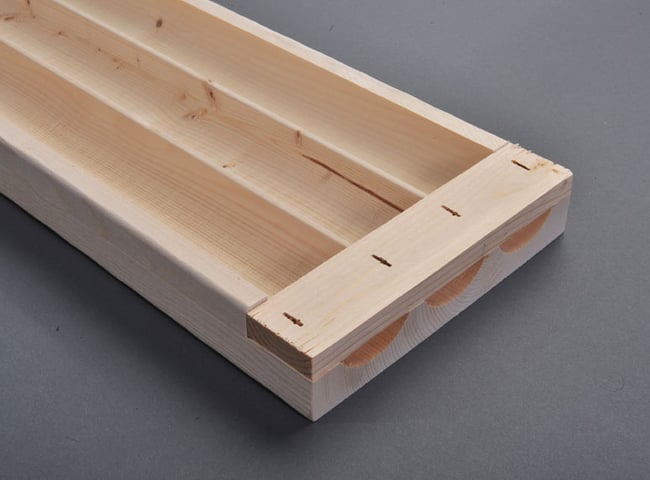
There is a much more basic way of manufacturing these with timber and plywood base and lid, where you cut your pieces to size and knock it all together.
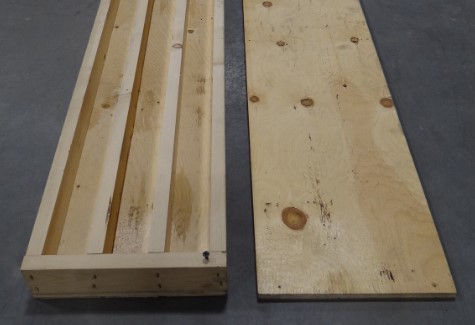
So yes, overall, there is a bit of machinery involved and labor in piecing these together. Then enhancing or protecting the integrity of the product with the kiln dry and sealing process by hand.
Bottom Line
Wooden Core Box Typical Price
HQ Box - USD$8.00-10.00
Core Capacity: 9.84 ft or 3.0 meters
Equal to $0.81-1.02 per ft or $2.66-3.33 per meter of core
Plastic Core Boxes Manufacture Process
Each plastic core box is injection-molded from a huge 1-2 tonne mold.
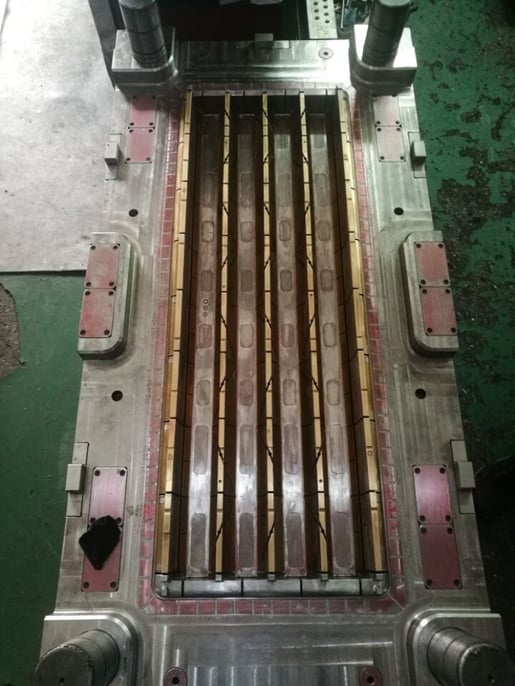
These molds may be worth $100,000 plus, but once they are in place the consistency of which they can produce a high-quality product is unparalleled.
These machines can produce 1 core tray every 50-70 seconds, depending on whether it's a NQ or PQ core box.
The more plastic, the longer the cycle time to produce.
If you've got 2 or 3 of these machines, you can have a robot or single operator removing the trays, and stacking them onto pallets.
It's production line par excellence.
So, although you are coming out the other side with a product with a lot more benefits, the repetitive production is simple.
For example, the Discoverer® Core Tray is produced on 9 machines around Australia 24/7.
Bottom Line
Plastic Core Box Typical Price
HQ Box - USD$9.00-11.00
Core Capacity: 13.12 ft or 4.0 meters
Equal to $0.69-0.84 per ft or $2.25-2.75 per meter of core
Wait, to make it easy, let's put that Core Box Price Comparison all in one place for you.
Cardboard vs. Wooden vs. Plastic Core Box Price Comparison
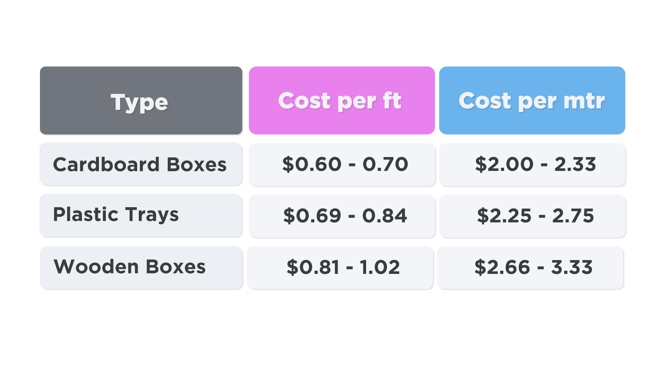
Now, is that interesting reading?
Yes, we get it, there are other very tangible factors involved.
The main one being that, it's always going to cost less to ship a flat-pack product than a fully assembled product.
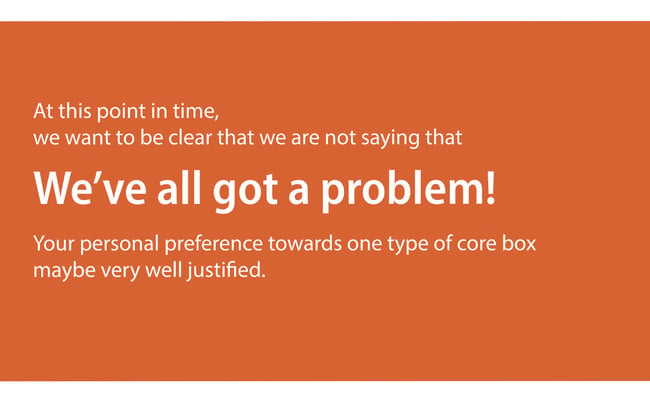
The whole object of this article is to be insightful, and speak to geologists who say,
"Ahh, I never thought that option was open to me."
or,
"I never realized this product could do that/eliminate this step."
So, before we go onto helping you find out which of these options are available to you locally, let's talk about industry best practice.
What is the industry best practice for drill core storage?
This becomes quite hard to write about because each region of the world has so many variations.
Let's try to open with the burning questions.
To get the most out of this exercise, you need to physically write down your answers to each question in sequential order before you move onto the next question.
1. How much cash do you invest in the core you drill per ft or m?
Be honest with yourself to get the best results. Think about costs such as all-inclusive drill cost, core cutting/assay costs and logging costs.
2. Now you have accurate costs, how does this investment in the core sample process per foot or meter compare to the cost of the core box per foot or meter?
From talking to geologists all around the world, we've come up with a mean average infographic below.
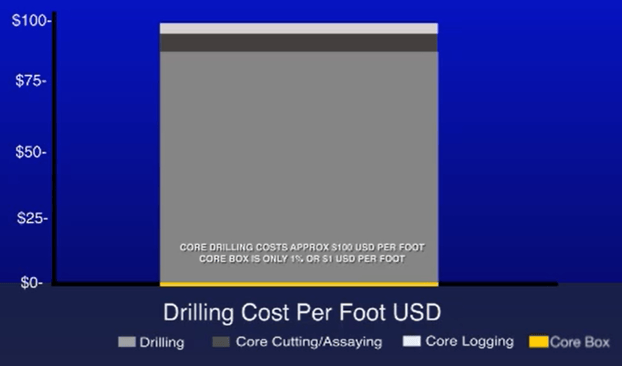
You can tweak this to suit you. But if you get an answer that your core box is worth more than 5%, you have a unique project.
However, we'll invite you to put it at 10%, worst-case scenario.
Isn't it worth spending an extra 5-15% per core box to protect this data which is the geologist's primary goal?
It seems irrational to go for the cheapest possible core box if it means forfeiting your primary goal.
Something to think about.
3. How important is it to show your investor and shareholders you carefully preserve their funds for them to gain confidence in the investment they've made?
As a global industry, the investor confidence question is always a burning one.
If you can't display competence, funds don't come.
One of these ways is by displaying a best practice core storage facility.
Core is all you have left after thousands of dollars of investors' cash; you've got to show you care for it.
This strategy is guaranteed to attract investor attention.
4. Do you photograph each one of your core trays?
A systematized library of historical drill results can be one of the most powerful assets any mining company can maintain. Period.
5. Do you rename all the photographs with the box # and to and from depth or similar?
A picture is worth nothing without reference to exactly where it came from; you might as well have not taken it.
6. If you could take a single image of your core box, and have software automatically perform the photograph renaming and assign it to the corresponding database, what would that be worth to you?
The thought of the countless hours geos and fieldies spend on this brain-deadening process when they could be unearthing the next big discovery nearly makes us cry.
Automate the blessed process!
Any further thoughts here?
Are we biased?
We could well be. We definitely lean heavily towards plastic.
We believe that within 10 years, the whole world will change to a plastic core tray due to the features that enhance the product.
If you're not using one, we believe you will be losing out on serious workflow efficiencies, whilst other miners become more competitive.
But it's not up to us.
It's up to you.
All we can seek to do is provide the most unbiased comparison possible.
Some people will always want the cheapest conceivable product, without reflecting on value for money or ROI.
They may be prepared to overlook the end-game or not see enough merit in it.
It will take a holistic thinking geologist to push this 'new concept' to some markets. And if they succeed, boy will they receive the accolades!
All this time, other markets and geologists have been using plastic for decades.
That being said, sometimes, it simply comes down to what's easy to source locally.
We get it—drill programs happen last-minute.
Let's explore this.
What core boxes are available in my region?
We'll explore this by continent, and country of origin.
The most interesting situation here is that most continents will be manufacturing the 'traditionally' used core box.
It's rare to see much innovation.
For this reason, plastic core boxes such as the Discoverer® product are imported in when the mining company demands a higher standard.
The world is a very small place, and you can get a Discoverer® plastic core tray on-site within 30-90 days, anywhere in the world, dependent on remoteness.
As we stock the product, there are times this would be faster than local supply.
Who manufactures core trays in Africa?
All core boxes in Africa are manufactured in South Africa.
This can be an issue as South Africa might be geographically close, but moving stock between African countries can be more difficult and time-consuming than purchasing directly out of Australia.
Therefore companies in West and North East Africa regularly purchase plastic core boxes directly from Australia, because it's easier!
Listed below are the 3 major manufacturers in Africa.
UCP Africa
Where: Johannesburg, South Africa
Supply: Combi Design Plastic Ends and Metal Body Box
Extras: Assembly on Site Required
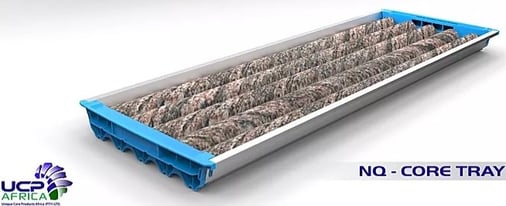
Africore
Where: Plettenberg Bay, South Africa
Supply: Field and Factory Assembled Metal Trays
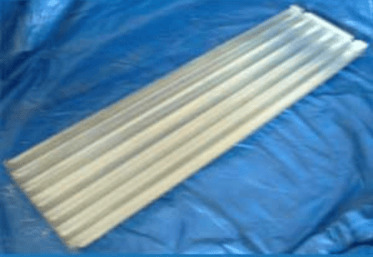
Terracor
Where: Johannesburg, South Africa
Supply: Field and Factory Assembled Metal Trays, Plastic Core Trays
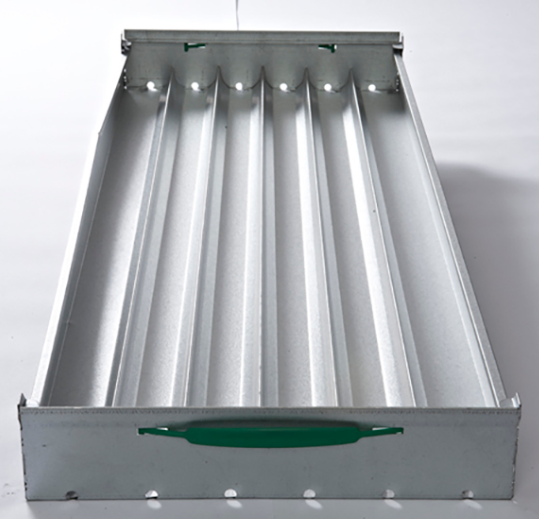
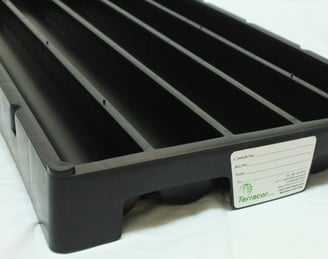
Discoverer® Core Trays - Available throughout Africa
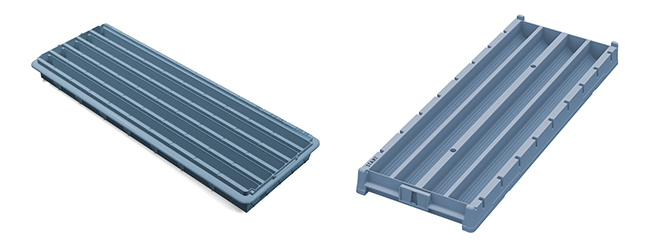
Rock Solutions Limited
Servicing: Tanzania as a sole distributor
Geoterrain Nigeria Ltd.
Servicing: Nigeria
Gulf Minetech, Dubai
Servicing: Northern Africa - Algeria, Egypt, Libya, Morocco, Sudan, Tunisia, Western Sahara
Dynamics G-Ex
Servicing: All countries in Western Africa, Central Africa, Eastern Africa, Southern Africa
As long as there are no trade sanctions, Discoverer® Trays can be imported into any African country.
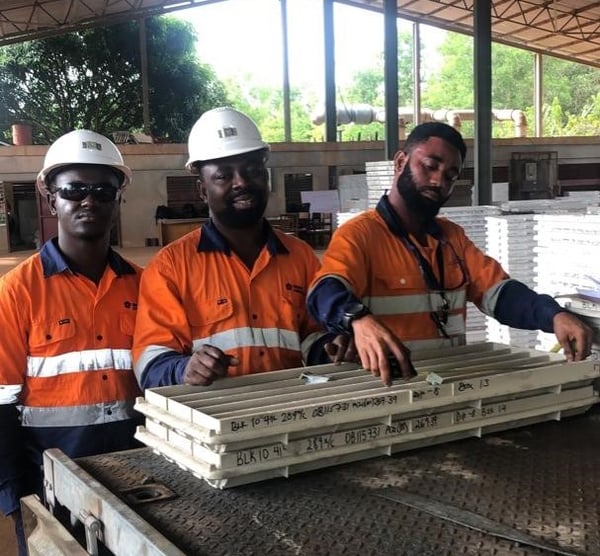
Who manufactures trays in South America?
South America is showing promising advances in the innovation of the humble core box.
There is an active pursuit of plastic sample trays; being a typically hotter climate, termites have a lot to do with this.
In Portuguese, a core tray is known as a 'caixas de testemunhos de sondagem'.
Translated in English, it means 'testimonial box', pointing to the fact to the core bearing 'testimony' to what's below the ground.
In Spanish, a core tray is known as a 'caja testigos'.
Its English translation is 'witness box' - yet another reference to the core being a 'witness' to Mother Earth wonders.
Listed below are South America's main core box manufacturers.
Boxiplast
Where: Lima, Peru
Supply: Plastic Core Trays
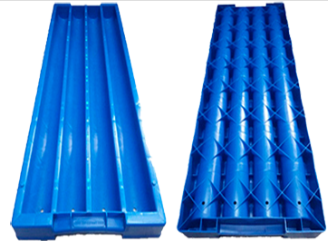
Geo Equipos
Where: Santiago, Chile
Supply: Corrugated Celuplast Plastic Core Witness Boxes (Cajas Portatestigos)
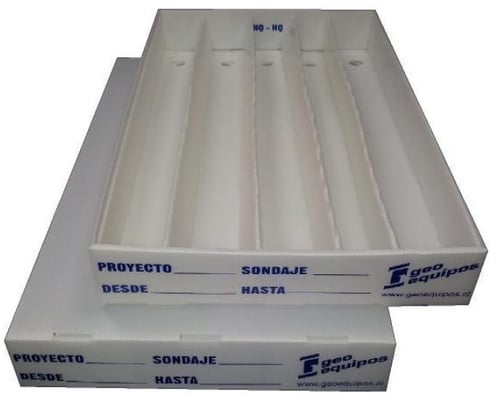
Granlog
Where: Lima, Peru
Supply: Corrugated Celuplast Plastic Core Witness Boxes (Cajas Portatestigos)
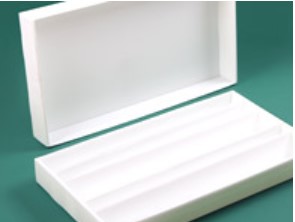
CoreCase
Where: Rio Grande do Sul, Brazil
Supply: Recycled Plastic Core Box
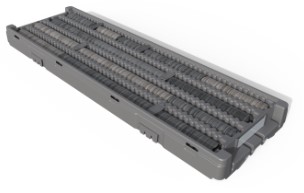
Coeur Products
Where: Hermosillo, Mexico
Supply: 100% Wax Impregnated Core Box
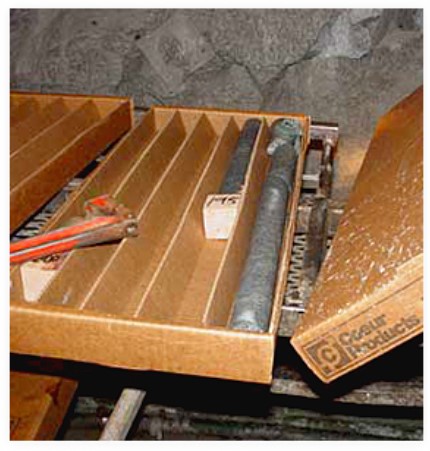
Discoverer® Core Trays - Available throughout South America
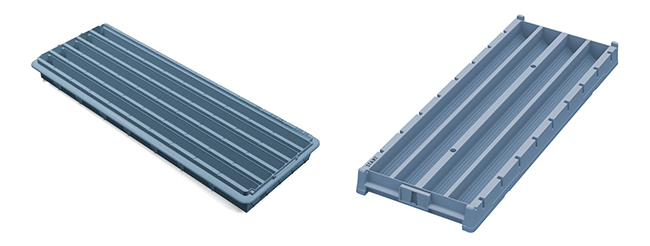
Caba Holdings
Where: Santiago, Chile
Servicing: Argentina, Bolivia, Chile, Colombia, Ecuador, French Guiana, Guyana, Peru, Suriname and Venezuela
Anyone we've overlooked that you reckon that's worth a mention?
Let us know!
Who manufactures core boxes in North America?
This is where we get two distinct differences.
In the USA we see the majority manufacturing a Wax Impregnated Cardboard Box, as previously discussed.
Canada, on the other hand, is mostly manufacturing Wooden Core Boxes.
So let's split these regions up.
Wax Impregnated Cardboard Box Manufacturers in the USA
Midway Packaging Supply, Inc
Where: Duluth, Minnesota
Supply: 100% Wax Impregnated Core Box
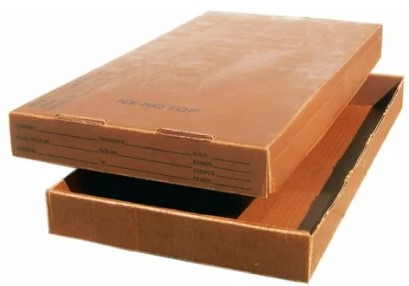
CGS Mule
Where: Sparks, Nevada
Supply: Range of Core Boxes and Core Trays

Hole Products
Where: Locations across USA & Mississauga, Ontario
Supply: Range of Core Boxes and Core Trays
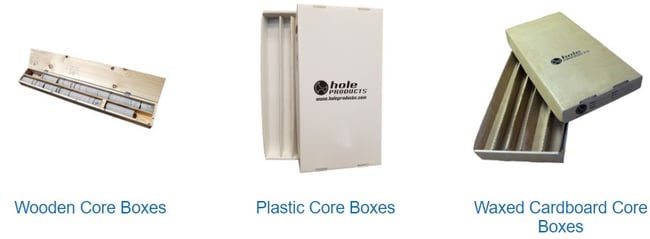
Coeur Products
Where: Coeur d’Alene, Idaho & Elko, Nevada
Supply: 100% Wax Impregnated Core Box

Wooden Box Manufacturers in Canada
K-7
Where: Val-d'Or, Québec
Supply: Wooden and Plastic Core Boxes
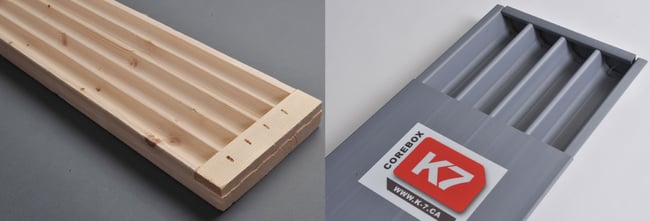
Di-Corp
Where: Edmonton, Alberta
Supply: Wooden Core Boxes
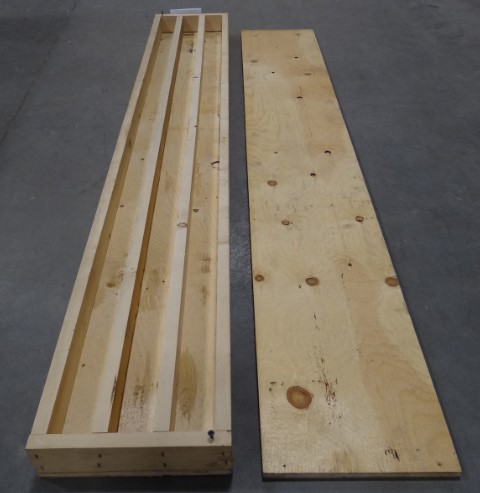
Robertson Mfg Ltd
Where: Kamloops, British Columbia
Supply: Wooden Core Boxes, Partially Assembled
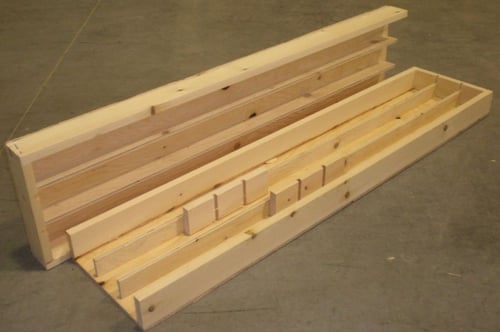
Garden Lake Timber
Where: Thunder Bay, Ontario
Supply: Wooden Core Boxes
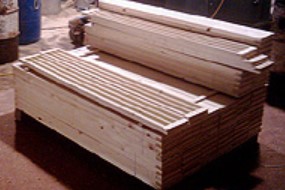
Who manufactures core trays in Europe?
Altinoluk Plastik
Where: Konya, Turkey
Supply: Plastic Core Boxes
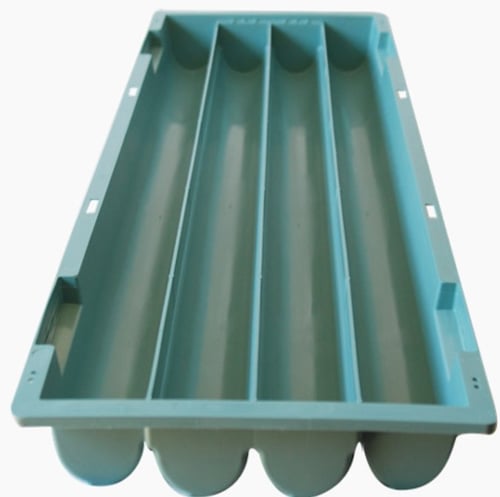
Discoverer® Core Trays - Available throughout Europe
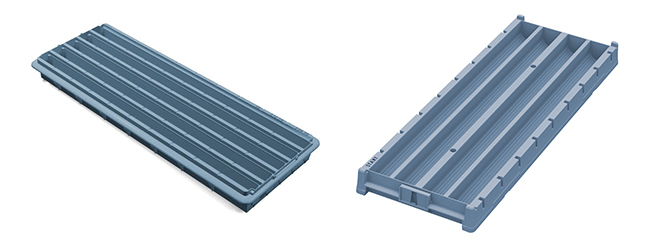
Drilling Supplies Europe
Where: Northern Ireland
Servicing: Portugal, Spain, France, Belgium, Netherlands, UK, Ireland, Italy, Germany, Greece, Ukraine, Poland, Sweden, Denmark, Finland and Norway
Anyone we've overlooked that you reckon that's worth a mention?
Let us know!
Who manufactures core trays in Asia and the Middle East?
We are going to be upfront with you here.
It's very difficult to tell who manufactures what in Asia or the Middle East.
We do know that some metal core trays are made in India, but there are quite a few middlemen and agents that we aren't able to work out the manufacturers at this time.
However, the largest miners in India seem to purchase plastic core trays out of Australia, more than likely because the quality is reliable.
Discoverer® Core Trays are imported into Asia and the Middle East regularly.
Discoverer® Distributors in Asia
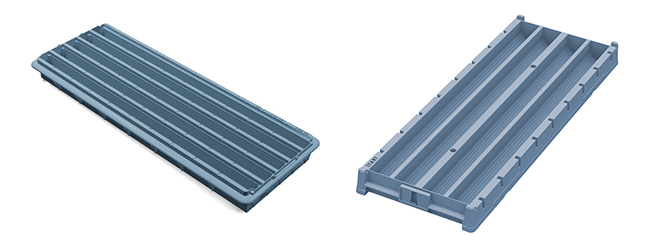
Global Mineral Services
Servicing: South East Asia – Laos, Thailand, Cambodia, Myanmar (Burma), Malaysia, Indonesia, Singapore, East Timor, Brunei and Vietnam
MIPSCOR
Servicing: Philippines
Uniglobal Trading Inc.
Servicing: Philippines
So that's it!
After all that, we don't believe that one practice is right and another is wrong.
Sometimes it solely comes down to personal preference.
But what the market trend is showing is that the solution that offers the MOST benefits for your entire exploration and mining project will win the day.
So are we all collectively mad?
Do we celebrate our individuality?
Or should there be a global standard, so no matter where you travel in the world, there's some consistency?
If plastic is the rising trend could it be manufactured locally and should we stick to that region's traditional sizing (e.g. 2ft in USA and 1.5m in Canada)?
This way, entire workflows wouldn't have to be changed. Roller racks and storage facilities could accept this new product.
Maybe the debate will never be resolved and rage on for years.
This article has taken 3 weeks to write, so if you enjoyed it, please join the conversation by adding to the comments below.
We are considering releasing an updated version every year to keep you updated with the latest innovations globally.
Feel free to reach out to the Discoverer Team if you have any comments or questions.


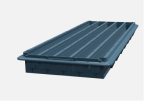

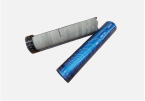
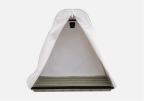
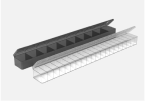

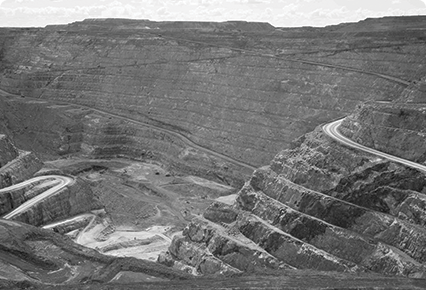
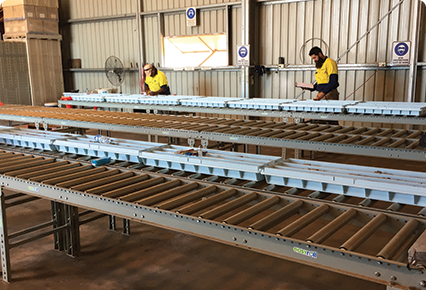
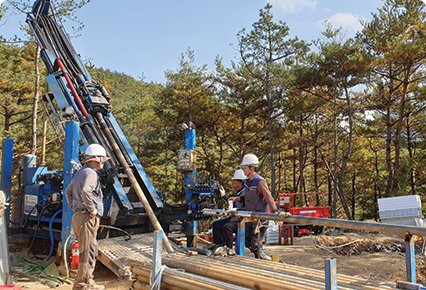
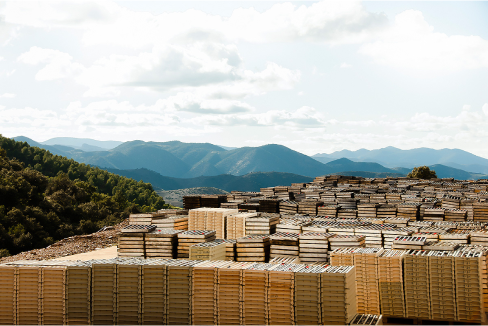





That sums up our 2022 Global Core Tray / Core Box Review.